GA3000 biogas analysis system at Harper Adams
At the £3.7 million AD plant at Harper Adams Energy, in Edgmond, near Newport, Shropshire, Plant Manager, James Wood monitors biogas composition automatically, 24/7 with a Geotech GA3000 static gas analyser. He wants his own independent analysis of the gas mix, and to record it in detail automatically, especially the percentage of methane (CH4), hydrogen sulphide (H2S) and carbon dioxide (CO2). James Wood said, “We want our own gas analysis record of the biogas quality we are sending to the 496kW Jenbacher CHP engine or to flare. To control H2S we dose with ferric sulphide every day. The amount is determined by the H2S percentage reading from the Geotech GA3000. It also shows if there is too much CO2 and we also rectify that.” This careful management of the plant contributes to avoiding unplanned CHP downtime at a direct revenue loss of some £2000/day (11.8MWh of electricity). During the specification phase, James Wood confirmed that he selected the GA3000 as it was designed for biogas and had appropriate moisture control and gas conditioning built-in.

Biogas is collected from each of the five processing tanks which include the primary and secondary digesters, two buffer tanks and also the pasteurisation tank. It combines in the gas holder at about 15Mbar. The Geotech GA3000 samples the biogas in the tank continuously from where it goes to CHP or flare or boiler. Data from the GA3000, via four 4-20mA outputs, feeds into the plant’s SCADA system where it is on permanent display showing current readings and the updated average for the last 24 hours. James Wood is able to check gas production analysis as it happens. He has every reading recorded automatically since the plant started to run. From that data he observes trends and can see the result of operational changes, essential for continuously improving plant performance, efficiency and revenue.
The anaerobic digester plant started generating heat and power in May 2011. Using a continuous feed of farm and food waste, it is anticipated to offset the university campus carbon emissions more than three times over and save over 13,000 tonnes of CO2. It feeds electricity to the campus population of some 2500 people and the plan sells surplus, unrequired electricity to the grid creating an income.
Renewable electricity is produced from food and farm waste and provides a highly effective waste management system. The waste is digested in the AD unit and recycled into 23,000 tonnes of liquid, nutrient-rich fertiliser for use on University College farm, reducing reliance on chemical-based fossil-fuel created fertilisers. The feedstock comes from 8,500 tonnes of municipal food waste from households, restaurants and food production which would otherwise go to landfill. It joins 17,000 tonnes of dairy cow and pig slurry pumped to the AD plant from the University farm’s 400 cows dairy unit and its 2,500 pigs.
Designed and built by BiogenGreenfinch, the Harper Adams Energy plant has also been shortlisted for two categories in the prestigious Renewable Energy Infrastructure Awards – ‘Best Use of Biogas’ and ‘Renewable Electrical Facility Award’. Project partner E.ON assisted with the plant. Paul Moran, Estates and Facilities Manager at Harper Adams University College, has been crowned Energy Manager of the Year at The Energy Institute’s Environment and Energy Awards 2011. Meanwhile the Geotech GA3000 automatic gas analyser is monitoring the plant’s biogas tank continuously.
More in http://www.geotech.co.uk/ga3000_harper_adams.php
